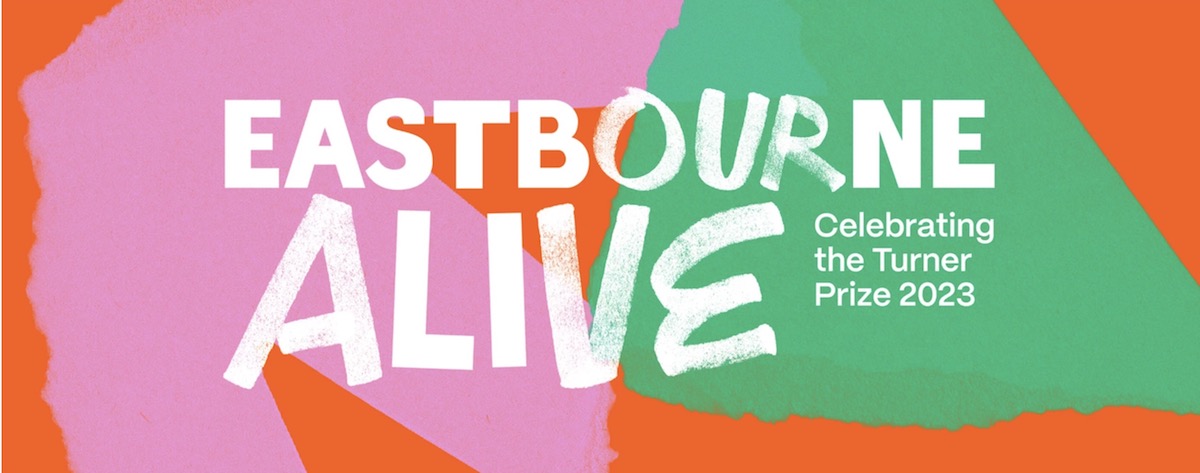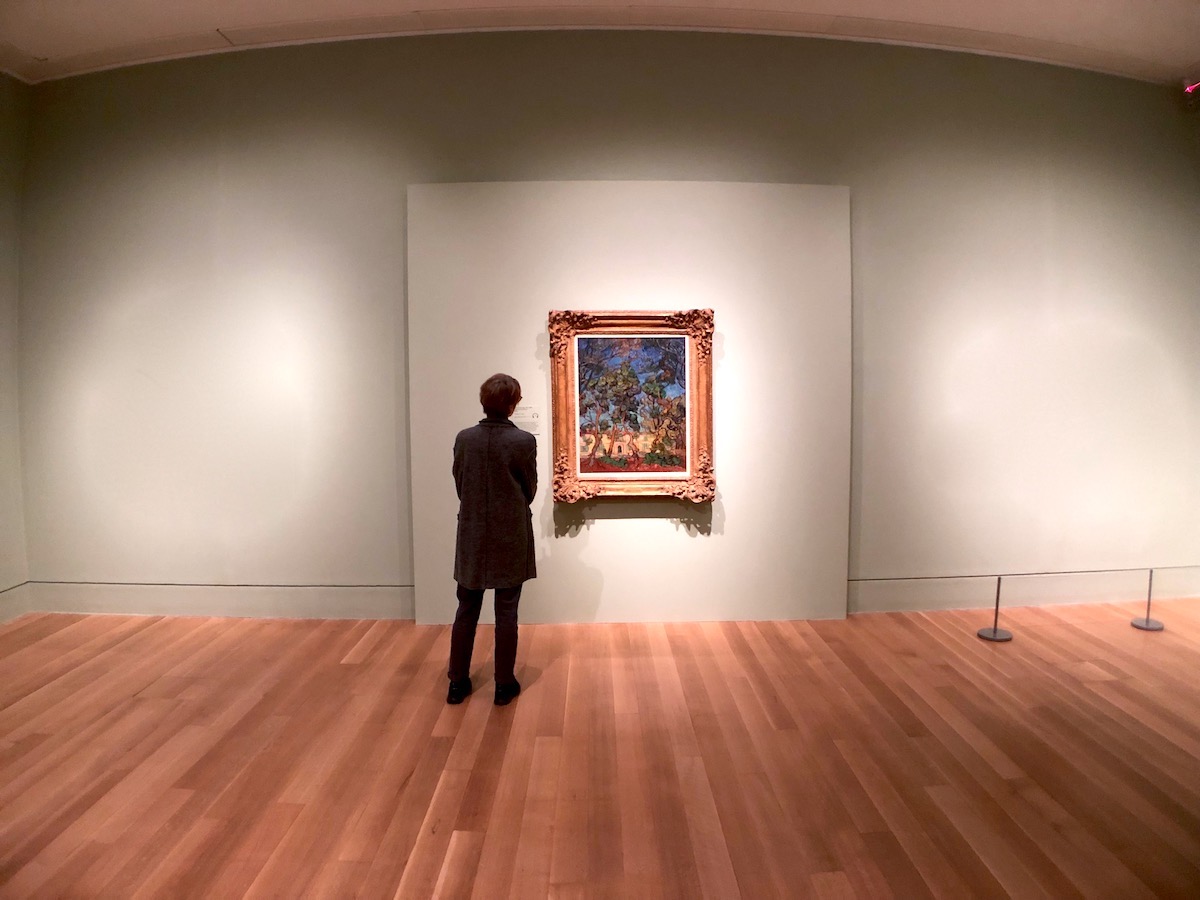With 30 kilos of luggage, just enough to hold his most precious items, Vincent boarded the train heading back North on May 16th, 1890. After a few days in Paris he travelled to Auvers-sur-Oise, thirty kilometres from the capital, not far from where his brother was. There he met Doctor Gachet, a physician who was a friend of many artists and had been recommended to Theo by Camille Pissarro.
After a year spent in Saint-Rémy he couldn’t wait to get out of the clinic where the patients around him were left to vegetate in an “awful idleness”, “simply a crime”, as he wrote to Theo, “not a book, nothing to distract them”. He was leaving behind his last sun, an imaginary disc that floods the large canvas in yellow, in his work The Raising of Lazarus, after Rembrandt, painted two weeks before leaving. He would never paint another sun – there is not a single sun depicted in the skies of the canvases he completed in Auvers. In the last months of his life he became more prolific than ever before: more than one painting per day, 74 in all, and then dozens of drawings, large and small sketches. And, again, a new Van Gogh.

Van Gogh in Auvers. His Final Months is the title of the new exhibition that the Van Gogh Museum is dedicating to the Dutch genius, in collaboration with the Musée d’Orsai (until 3 September 2023 – and in Paris, at the Musée d’Orsai, from 3 October to 4 February 2024). Curated by Nienke Bakker, Teio Meedendorp, Louis van Tilborgh (Van Gogh Museum) and Emmanuel Coquery (Musée d’Orsai) the exhibition brings together for the first time fifty paintings and many drawings, with loans from thirty museums around the world, and several private collections. Thus, we can finally explore this crucial, and hitherto somewhat overlooked period of the painter’s life. The series of ten panoramic landscapes painted in Vincent’s final weeks are one of the spectacular features of the show. This once-in-a-lifetime exhibition celebrates the fiftieth anniversary of the Van Gogh Museum, officially opened on June 2nd 1973 by Queen Juliana. Over the past decades, thanks to the dedicated work of its innovative multidisciplinary team of researchers, the Museum has become an invaluable point of reference for Van Gogh’s studies. This fundamental milestone will also be celebrated outdoors on June 2nd, on the green of the Museumplein, the venue hosting the Sunflower Art Festival.
“The heart of the countryside”
Having spent a few days in Paris with Theo and his new family, Vincent left for Auvers where, on May 20th, he found lodgings at the Café de la Mairie, run by Arthur Ravoux.
The countryside had a calming effect on him, the chaos of the capital was not for him, and now his masterpieces began to take shape. An Old Vineyard takes on a fantastical and surreal aspect among the roofs, chimneys and clouds, a woman melds with the scene. This is the first big drawing that welcomes us into the exhibition, and tells us that something inside Van Gogh was already changing, that the new landscapes around him were inspiring him to experiment and try new things. It’s not simply a drawing: Vincent “rewrites” it with his brush, both in watercolour and in oil, and so painting and writing merge with each other, resulting in something totally new in his oeuvre.

Vincent van Gogh, Old Vineyard with Peasant Woman, © Van Gogh Museum, Vincent van Gogh Foundation, Amsterdam.
“Auvers is really beautiful, among other things many old thatched roofs, which are becoming rare”, he wrote to Theo, thoroughly charmed as soon as he arrived, “we are far enough from Paris for it to be the real countryside, but nevertheless, how changed since Daubigny. But not changed in an unpleasant way”, he noted, because “of the development of a new society in the old one”.
From the mid 1800s onwards Auvers had become a destination for many painters, and with the new railway station which opened in 1846, “artists could now explore the landscape around Paris much more readily, and so the Oise river basin, with its picturesque villages and varied nature, swiftly caught their attention”, as Teio Meedendorp writes in his contribution to the catalogue. At that time Jean-François Daubigny was “the artist most associated with the village”; but even before having a second home – made famous by Van Gogh – he navigated “up and down the river” in Le Botin to catch the changing reflections on the water by day and by evening, a favourite subject of his.
Van Gogh, instead, was attracted by the houses – perhaps the home he himself never possessed. Perhaps these roofs reminded him somewhat of Holland, and the cottages of Drenthe, which he had painted in the twilight, in the cold, or rather the homes of the peasants of Nuenen which he had called “those human nests”.
Vincent van Gogh, Farmhouses in Auvers-sur-Oise, © Finnish National Gallery, Ateneum Art Museum, Helsinki, Antell Collection.
And here the roofs of that “picturesque countryside” seem almost to melt and move, in the drawings and paintings, with a new expressive potency – very different from the static solar glow of the Yellow House we all know so well. Ever the trail-blazer, in Farmhouses in Auvers-sur-Oise Van Gogh attempts a new approach to clouds, an illusion to fool us with. He applies a white layer of paint in the upper part of the canvas, and then he “dirties” it with blue, with quick deft brushstrokes, which he cuts short to leave space for the billowing clouds. So, we have to re-examine this work with fresh eyes; it is not an incomplete work, amongst the last he produced, as some authors have suggested, it is instead a new experiment. The trees too are treated with the same decisiveness, making their highest branches seem to undulate. The locations of these paintings have been meticulously identified by Wouter van der Veen, who, in his essay for the catalogue, presents an illustrated map of Auvers indicating Vincent’s painting. In this case we are near 67 rue Daubigny.
In Doctor Gachet’s Garden
Far from “Parisian things à la Baudelaire”, the little streets in the heart of the village offer many characteristic scenes, and the first area the artist explored was right around the Ravoux inn or the home of doctor Gachet – who he called on often, painting corners of greenery bursting with life and unexpected contrasts. An intense red roof is seen below the raised garden of the doctor, cutting diagonally across the composition; a shrub in the left foreground draws the viewer in, a vase beside it seems to fall out of the canvas – the roofs of some cottages in the background finally orient us. Dottor Gachet’s Garden is striking not just because of its audacious composition but also for its unusual proportions, a large closeup landscape, standing upright, ‘vertical’, 73 × 52 centimetres.
He simply describes it like this: “aloes with marigolds and cypresses”.
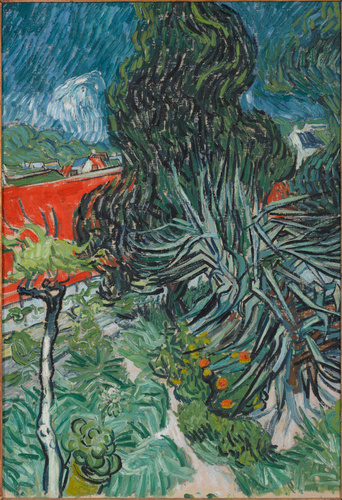
Vincent van Gogh, Doctor Gachet’s Garden, © Musée d’Orsai, Paris.
By now, Vincent had learned how to construct his own, personal window onto the world, and was experimenting with proportions inspired by prints of Japanese artists, who were great masters of composing vertical landscapes. The cobalt brushstrokes of the sky are laid quickly one after another, and invade the cypresses bringing the background to the fore – thus cancelling out the sense of depth we had perceived from the cottage roofs beyond.
We find the same palette in the portrait section, in the famous portrait of Doctor Paul Gachet who is shown leaning his elbow on a red lacquer table. His face is scored by the marks of time and sadness, his eyes are glassy. Depicted in the classical pose of Melancholy, his posture is so accentuated as to make him seem almost out of kilter.

Vincent van Gogh, Doctor Paul Gachet, © Musée d’Orsai, Paris.
In the first version of the portrait (not on show), this instability is even more evident, the subject seems barely able to hold himself up, the bust is positioned quite diagonally across the canvas, wavy, horizontal brushstrokes create movement.
Nothing is known of Vincent’s readings in the Auvers period, his new-found liberty exploded into work. But some books must certainly have been in those thirty kilos of luggage, because in the first version of the portrait of Doctor Gachet, on the same red lacquer table we see two novels, Germinie Lacerteux and Manette Salomon by the Goncourt brothers. He had “brought them to read”, his son Paul will write in his memoirs, in 1928. Germinie Lacerteux was one of Vincent’s favourite novels, a bitter mirror of his times – at the hospital in Arles he had even lent it to Reverend Salles. Vincent, who first thought the doctor “rather eccentric”, even “iller than I am”, soon came to consider him “a ready-made friend”. And like other friends from his past, nothing was better than a book to break the ice. This was one of his communication strategies – it is indeed noteworthy that in the first letters of his, both to Rappard (1881) and to Bernard (1887), he began by mentioning a book. Unfortunately, we have no record of any literary conversations between Vincent and the Doctor. In any case, Gachet encouraged him to work, saying it was the best thing to do in these “cases”.
Adeline Ravoux
“This week I’ve done a portrait of a young girl of 16 or so, in blue against a blue background, the daughter of the people where I’m lodging. I gave her that portrait but I’ve done a variant for you, a no. 15 canvas”, writes Vincent to his brother on June 24th. The first portrait is Adeline Ravoux, who was twelve at the time. Many years later, in her memoirs Adeline will describe Vincent as “a well-built man, whose shoulders leaned a little towards the side with the injured ear, with very lively eyes, sweet and calm, but with a personality disinclined to communicate. […] He never drank alcohol”. Vincent paints her in profile, but she sneaks sideways glances at him, and he captures even this tiny detail masterfully. Her hands seem nervous, betraying a certain impatience. “The presentation en profil, which is unusual in Van Gogh’s French work, lends Adeline the air of a Renaissance portrait” notes Nienke Bakker in her contribution to the catalogue. Vincent continues here with his blue-on-blue experimentation as he had already began exploring with the doctor, “a symphony in blue” Adeline remembered. He signed it for her, in red, in the lower left corner. This is the only painting that he signed during his Auvers period. Part of a private collection, this beautiful portrait has not been exhibited since 1955.
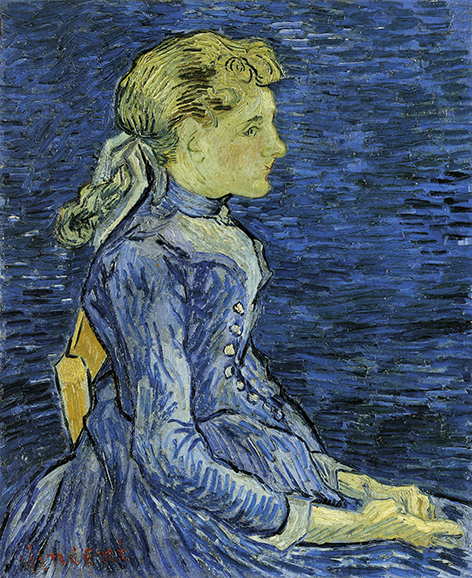
Vincent van Gogh, Adeline Ravoux, private collection – courtesy Home Art.
However, as the days passed with exceptional productivity – some 60 paintings in six weeks the latest research done for this exhibition reveals – the clouds forming on the horizon were growing ever darker. The story has been told many times. Vincent was harassed by grim thoughts, feeling that he was a burden on his brother, who now had a wife, Jo, and a four-month-old baby to look after. Things were tense between Theo and Boussod & Valadon too, and he was thinking of striking out on his own and opening a gallery; troubled times. On July 5th he spent a day in Paris, in the evening he returned to Auvers, sadness invaded his mind: “once back here I too still felt very saddened, and had continued to feel the storm that threatens you also weighing upon me”, he wrote a few days later. Highs and lows upset his thoughts.
Grand horizons. The final weeks
Between June and July, Vincent started working on large canvases, all works of one metre by fifty centimetres, for a project which will remain a mystery: visions of grand horizons. He neatly cut what he needed from the roll of canvas, two meters and 14 centimetres tall and 10 meters long that he had received from Theo, to create thirteen new works. “The brush however almost falling from my hands and – knowing clearly what I wanted I’ve painted another three large canvases since then. They’re immense stretches of wheat fields under turbulent skies, and I made a point of trying to express sadness, extreme loneliness”.
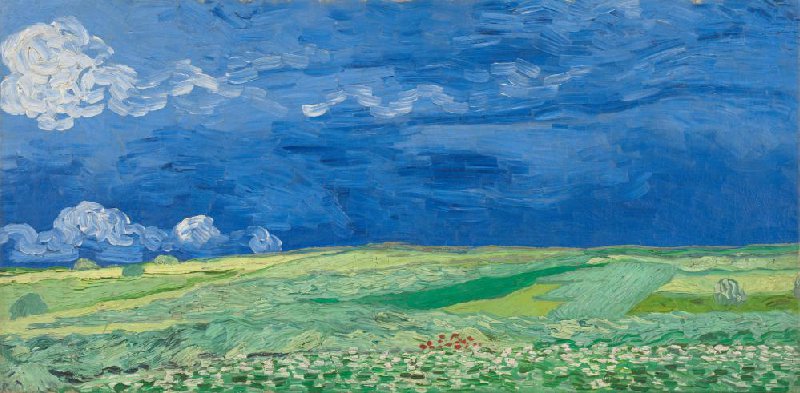
Vincent van Gogh, Wheatfield under Thunderclouds, © Van Gogh Museum, Vincent van Gogh Foundation, Amsterdam.
He no longer seeks the sun in the new horizons, he seeks the essence of the things of the world, the infinite in a symphony of green and yellow. “You’ll see this soon, I hope – for I hope to bring them to you in Paris as soon as possible, since I’d almost believe that these canvases will tell you what I can’t say in words, what I consider healthy and fortifying about the countryside”, he wrote to Theo and Jo.
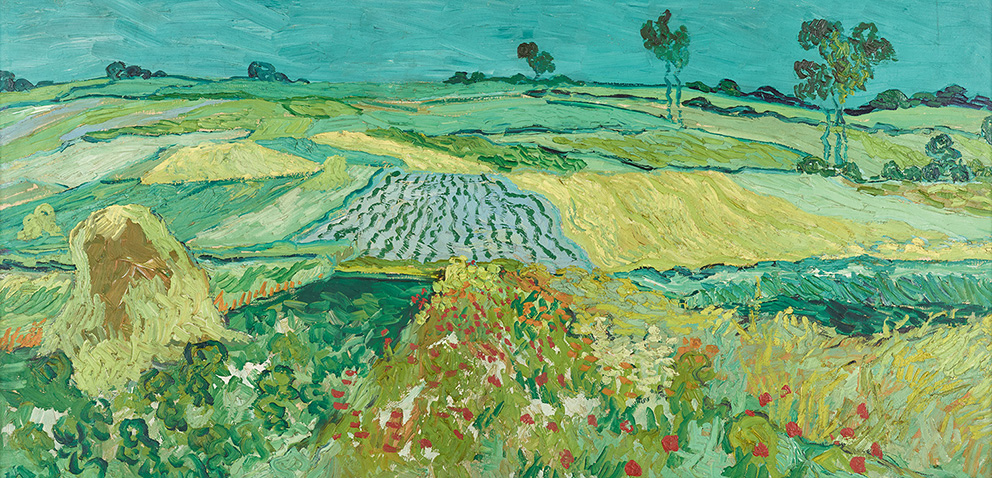
Vincent van Gogh, Fields near Auvers, © Belvedere Museum, Vienna.
Recent research with ‘Automated Canvas Analysis’ carried out on some 52 of the Auvers works, contributed to reconstructing the sequencing of the cuts Vincent made from the roll of ‘Tasset et Lothe’ canvas Theo had sent him. With this data, combined with the news from the letters, the memoirs of Doctor Gachet’s son, and the metereological reports, the curators have been able to date (day after day) even the thirteen canvases of one metre by fifty centimetres; the “double-squares”. A format which “is notable because of its round figures, unusual in its display of geometrical intention”, comments Emmanuel Coquery in his essay, it must have been a very deliberate decision, “a special project”. In Paris, Vincent had been struck by the monumental work of Puvis de Chavannes Inter Artes et Naturam, which may have inspired him. While still in Holland he had created some drawings and paintings in an elongated format (following in the footsteps of Daubigny or the Dutch masters), but nothing quite so systematic as these.
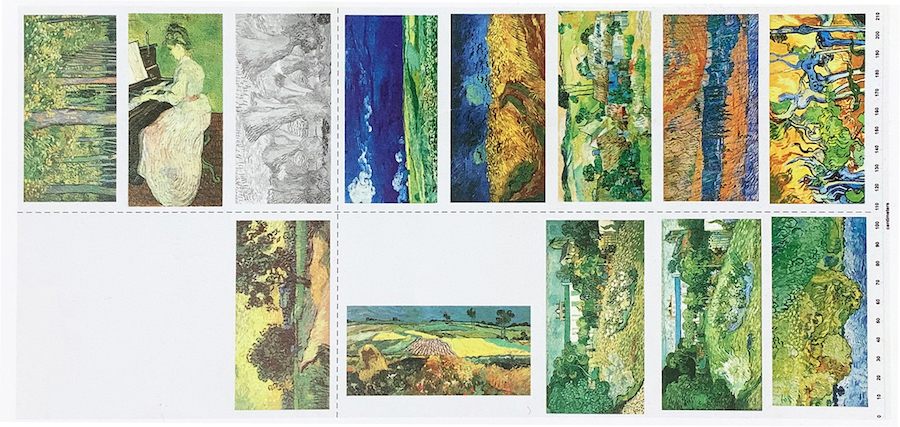
Reconstruction of the thirteen ‘double-square’ canvases cut from the Tasset et Lhote roll of canvas. Published in: Van Gogh at Work 2013, p. 217, courtesy and © Van Gogh Museum, Vincent van Gogh Foundation, Amsterdam.
The result is spectacular, the immense panorama of Vincent is brought together for the first time. Ten of these canvases are displayed here, alongside each other in a sequence which reveals the evolution of his mysterious project. Many triptychs? Perhaps. In his letters there are some clues, for example he noticed that Marguerite Gachet at the piano “looks very good with another horizontal one of wheatfields”, he made a sketch of this in his letter of June 28th (sadly the original is lost, a photograph of it remains).
Since the beginning of his artistic career, Vincent had created diptychs and triptychs – we have a lovely example in Arles, in the Spring of 1888. Enchanted by flowering orchards, he had in fact drawn a sketch of a triptych on a letter to Theo, specifying that he had already painted “6 canvases” of the same theme, and was trying “to finish them a little every day, and to make them go together”. The year before, in Paris, he had dedicated a group of nine paintings to the shores of the Seine, all of them with “red painted borders”, as Martin Bailey points out.
Nonetheless we are now facing numerous canvases in an identical format but with very different subjects, and we can only look back and forth along this long wall showing the visions of a genius. So we see again Wheatfield with Crows (which popular myth insists on linking to the day of his suicide), presented in between Fields near Auvers and Wheatfield under Thunderclouds (illustrated above). The effect this has merits pause for reflection – they do indeed go well together.
Vincent van Gogh, Rain – Auvers-sur-Oise, © National Museum Wales, Cardiff.
Other extraordinary landscapes follow, like Rain – Auvers-sur-Oise, or Farms near Auvers. A truly “extreme” solitude and poetic sadness emerge. This new ‘language’ comes out more with each painting. There are no figures.
The treatment of space in the last paintings goes well beyond the forms he had typically used until then.
The work on rain seems almost woven in flat, horizontal patterns, vertical lines cross it, perspective has been abandoned – reinventing what he learnt from Japanese compositions. And yet, in his paintings, Vincent creates from reality, as photographs of the epoch confirm. His new approach to Painting is, however, becoming more and more daring.
His last canvas, Tree Roots, painted Sunday July 27th, a few hours before his fatal decision, is a dance with nature, harmony of colours, of an old love, “gnarled roots”. Once again, Vincent draws inspiration from a real place. It is not the undergrowth of the woods of Auvers, but a slope facing onto a road, Rue Daubigny. The precise spot has recently been identified by Wouter van der Veen thanks to an old photograph. It seems unthinkable, but these large, giant roots are still recognisable today. Vincent had placed his easel on this roadside, not far from the Auberge Ravoux. Perhaps some passer-by stopped for a look, or perhaps they ignored him…
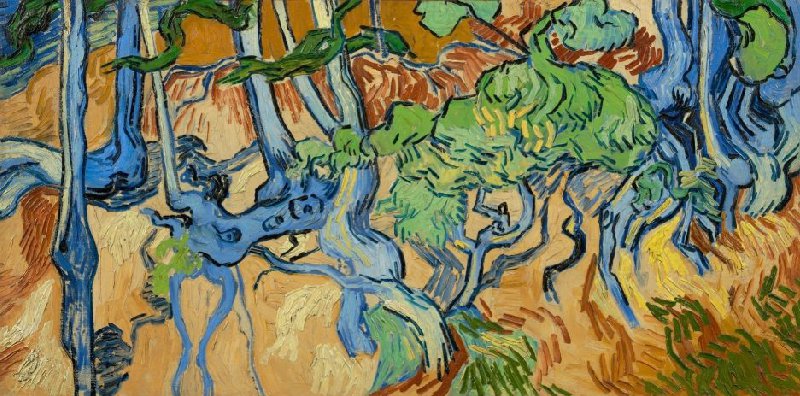
Vincent van Gogh, Tree Roots, © Van Gogh Museum, Vincent van Gogh Foundation, Amsterdam.
But such discontinuity, such a break with his own production had not been seen before – a vertiginous revolution, an encounter with absolute novelty.
Friends’ letters
We don’t find quotes from letters alongside the paintings this time, the curators have decided to let the works speak for themselves. But in the last section of the exhibition Vincent’s friends are given a voice, in many moving written testimonies, sent to Theo and the family. Here, for example, are the words of
Albert Aurier to Theo, “I do not need to tell you – you must be aware of it – how great an admiration I felt for the artistic qualities of the man you are mourning today. I will therefore only add one word: men like him do not die entirely. He leaves behind a body of work which is part of himself and which, one day, you and I can be sure, will make his name live again and again for eternity”.
In the final months of his life Vincent produced an exceptional body of work, seeing them exhibited together is an experience that amazed even the show’s curators. It is extraordinary how, after a year in Saint-Rémy, Vincent took up the themes nearest to his heart once again – landscape, portrait and still life, taking on a new challenge with Painting and with himself: intense experimentation on landscape, colour and format.
He needed nothing, he found subjects for his art everywhere.
Van Gogh in Auvers. His final Months – Van Gogh Museum, Amsterdam 12 May – 3 September 2023
Van Gogh à Auvers-sur-Oise. Les derniers mois – Musée d’Orsai, Paris 3 October 2023 – 4 February 2024
Further reading:
The exhibition catalogue Van Gogh in Auvers-sur-Oise is edited by Nienke Bakker, Teio Meedendorp, Louis van Tilborgh (Van Gogh Museum) and by Emmanuel Coquery (Musée d’Orsai), with contributions of Bregje Gerritse, Sara Tas and Wouter van der Veen. A section is dedicated to the “Catalogue of Paintings from Auvers-sur-Oise” (Thames and Hudson 2023)
• Among recent books: Who Shot Van Gogh? Facts and Counterfacts about the World’s Most Famous Artist by Alan Turnbull, examines the contradictions of Van Gogh’s mythologized existence (Thames & Hudson, 2022); Vincent’s Arles. As It Is and as It Was by Linda Seidel takes us to the places immortalized by Van Gogh and cherished by visitors and pilgrims. (The University of Chicago Press, 2023). For more on the story of the Van Gogh Museum, see Choosing Vincent. From Family Collection to Van Gogh Museum, edited by Lisa Smit and Hans Luijten, with contributions of Fleur Roos Rosa de Carvalho, Anita Vriend and Roelie Zwikker.
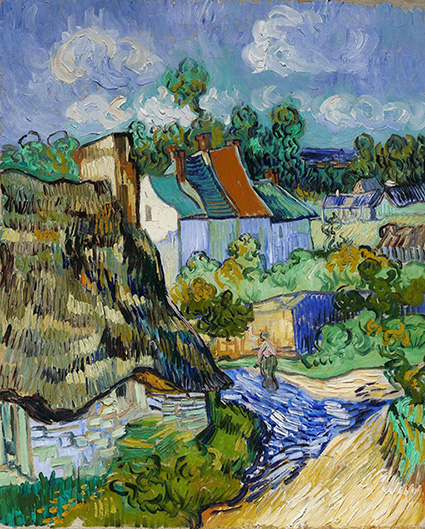
Vincent van Gogh, Houses at Auvers-sur-Oise, Museum of Fine Arts, Boston.
